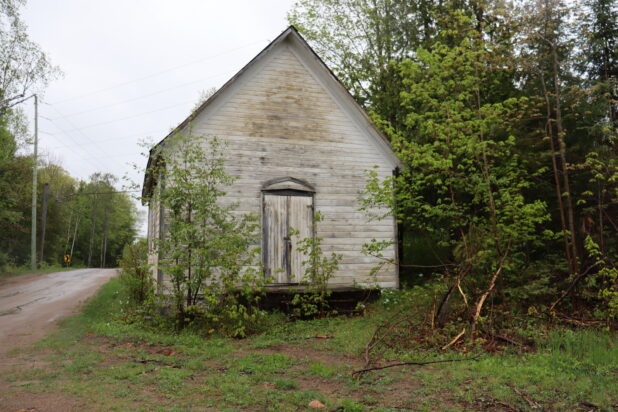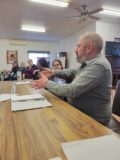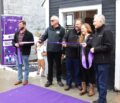General News
Historic Faraday church building under tax sale
May 18, 2022

By Mike Riley
Local Journalism Initiative Reporter
An historic Faraday building, once a church but in later years a library, is facing a tax sale over unpaid taxes and legal fees. The deadline for the tax sale in May 25. Concerned local residents Dave Eakins and Terry Campbell presented to Faraday council at their meeting on May 4 to try to get the tax sale suspended to allow them to save the building for its historical relevance, but were unsuccessful. Council ultimately voted to maintain the tax sale, with Deputy Mayor Marg Nicholson abstaining from the vote due to her view that the tax sale should have been suspended to allow concerned community members to come up with an alternative plan for it.
The building in question, at 14 White Church Road, is a former church that was later turned into a library. It was posted on Facebook’s Bancroft and Area History page on April 25 by Dan Kehoe as an historic building now facing a tax sale. It was built in 1894, and was originally a Methodist and later a United church. According to Switzer, the United Church sold it in 1970 to the board of trustees for the Lower Faraday Community Centre for $5. The last known owner was the aforementioned board of trustees, care of Coe Hill resident Marilyn Peacock.
However, Ms. Peacock passed away in 2013, and the first tax bill was sent out in 2017, according to Eakins.
“Her husband Brian returned the bill to the township unopened and informed staff that she was deceased. Apparently, no change was made and that is the address still associated with the property. Apparently, no living person has ever received a tax bill addressed to them, nor did any living representative receive notice of the tax sale. When the advertisement hit the newspaper was the first anyone outside the township staff was aware, yet council wouldn’t even grant us time to prepare a formal proposal to save this piece of history,” he says.
Eakins and Campbell presented to council on May 4 about the old church building and its historical significance to the community. Eakins told them it was an integral part of history.
“Somehow, it’s fallen through the cracks. The first we knew of the tax sale was the ad in the paper. As I said, it’s been oversight and neglect on everybody’s part,” he says.
Eakins and Campbell asked council to remove the building from the tax sale as they had several ideas kicking around for the future of the building, including restoring it and/or having it moved to another location like near the Santa’s Village house next to the Bancroft municipal office.
Campbell noted that Rathburn Lumber donated the land for the church back in the late 19th century and that all the lumber to build the church had been donated by John Tinney, although it was later established that this was no direct relation to Councillor Carl Tinney.
Switzer replied to Eakin’s and Campbell’s request by saying that if council stopped the tax sale now and if nothing happens with the building as has happened before, they would have to start the process all over again.
“So there again, you’re looking at doubling the legal fees, which are already at $4,000. So, council would have to write that off and that’s the burden of all the taxpayers and the taxes that are owing,” she says.
Council suggested that concerned community residents, including Eakins and Campbell, could possibly come up with the money owing, $8,584.12 (which includes the taxes and the legal fees), by having a Go Fund Me campaign or something similar, and then it would be off the block and they could implement whatever plans they may have for it.
Councillor Tinney thought that the township should not be involved in this as it’s a community matter and should remain so, but Nicholson said that the problem with that is that if the building was to get an historical designation, it would need to come from a municipal council, as per the guidelines in the Ontario Heritage Act.
Eakins mentioned another historical fact about the church building; the first wedding performed at the church was in 1952 between Bob Ogilvie and Bernice Ingram.
“As I say, we really urge that we save this old building. For the insignificant amount it would garner in a tax sale, the historical value is worth a lot more,” he says.
Switzer says that council considered all comments and recommendations from Nicholson and from their legal counsel with regard to making a decision on the tax sale. She said that 14 White Church Road is not owned by the township and is not deemed an historical building.
“In completing a title search, it appears that the United Church of Canada sold the property and building to the Lower Faraday Community Centre board for $5 and it has not been a church since 1970. Churches are tax exempt. Members of the public inquired about the property again in 2017 and it was brought forward that 14 White Church Road was no longer owned and operated by a church; therefore, the property became taxable,” she says.
Switzer says that the township staff sent tax bills and notice of tax arrears to the address they had on file, and if they are returned to the office, they’ll confirm what address is listed in the assessment roll book and make changes if necessary.
“It is not the responsibility of the township to locate owners and an address cannot be changed without a written request from the owner. All notices for the tax sale proceedings were mailed out as required by the Municipal Act,” she says.
Upon hearing the news of council’s decision not to suspend the tax sale, Eakins said he was disappointed but not surprised. He says that he and the concerned community members are weighing their options, and says that one of the closest neighbours showed interest in buying it and turning it into a granny suite.
Nicholson drafted a memo to council on April 28 that noted the building’s historical significance and the part it had played in the Faraday community and suggested several options for council to consider going forward. These were; determining if the tax sale could be cancelled, if council had the legislative authority to do so then establish a committee to look at designating the land appropriately to preserve its historical, cultural and heritage value, or do nothing and let the tax sale go ahead.
Council ultimately voted to proceed with the tax sale, the exception to this decision was Nicholson, who abstained from the vote and told Bancroft This Week on May 6 that;
“I felt the tax sale could have been postponed in order for the parties to investigate a plan to declare the site of historical/heritage interest,” she says.
Unfortunately, the rest of council did not see it that way and voted to proceed with the tax sale. Hopefully, whomever ends up purchasing the property and building by May 25 will respect and maintain its history and heritage in some manner, so it can be appreciated by residents and tourists in the years ahead.


















